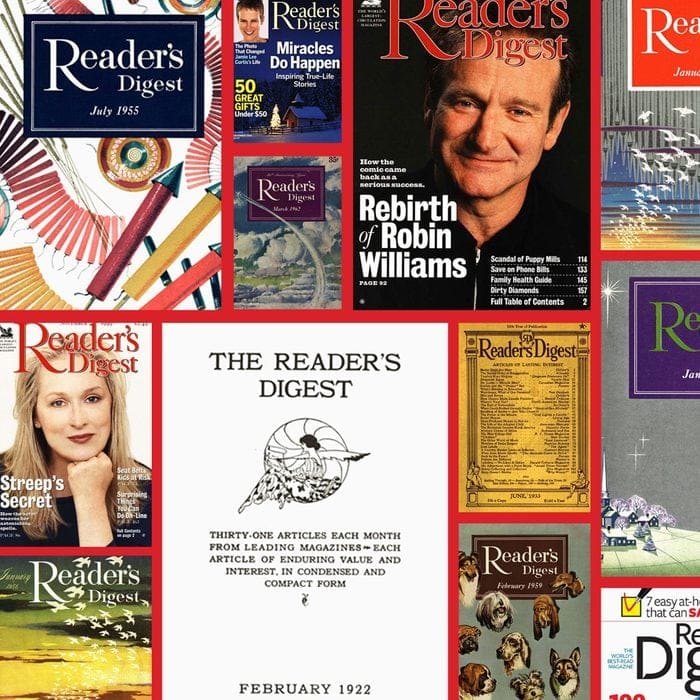Before photocopiers, VCRs, and the Internet, there was Reader’s Digest
My dentist can confirm that I’m long enough in the tooth to have witnessed three distinct Information Ages.

My dentist can confirm that I’m long enough in the tooth to have witnessed three distinct Information Ages.
The first involved newspapers and television and their fleeting, often unretrievable content. If you didn’t read an article or see a news program the first time around, you were out of luck. Unless of course, in the former instance, you snipped out every article you could find on your hometown Bruins — as I did to create an impressive scrapbook devoted to their championship 1969-70 season spearheaded by 21-year-old phenom Bobby Orr.
The second era saw the widespread introduction of photocopiers and VCRs, which allowed readers and viewers a chance to catch up on articles or shows they’d somehow missed.
Again on a personal note: During my high school years I dropped a number of dimes into the Medford Public Library’s sweet-smelling photocopier to reproduce the latest Woody Allen or S.J. Perelman piece from the New Yorker, the better to savor these master humorists over several readings at home.
Unfortunately, a VCR didn’t become a standard fixture in our house — or indeed across the U.S. — until the early 1980s, so I was unable to archive any worthy TV broadcasts from my boyhood such as “The Green Hornet,” a show whose title character didn’t appeal to me nearly as much as Bruce Lee’s Kato, whom I impersonated one year in a makeshift Halloween outfit consisting of a hand-me-down sport coat and a “chauffeur's cap” found in a random bin at J.M. Fields.
Today, Appointment TV, a defining feature of my cultural indoctrination, is well and truly kaput. Instead, we are in Streaming Time, when you can get instant content on any number of portable devices, meaning you no longer need to set aside a time and a place to watch an interesting program or peruse a favored print publication. As long as you have sufficient bandwidth and an adequate data allowance, the world comes to you, at your convenience, on a multitude of digital platforms.
Of course, before photocopiers, VCRs, and the Internet, old-timers like me had access to a prototype device, which channeled a variety of material from disparate sources into the palm of your hand.
The item in question was Reader’s Digest, which was offered on subscription (yes, our house was on their mailing list for a time) but could also be found free of charge in the waiting room of any reputable medical practitioner. Unlike technological relics such as rotary dial telephones and suitcase-size camcorders, however, Reader’s Digest is still with us. In fact, the current leadership celebrated a significant birthday not so long ago.
In February 1922, Reader’s Digest founders Lila and Dewitt Wallace published the first issue of their iconic magazine — which consisted of 31 uplifting articles from various publications, one for each day of the month — and the couple thus became “the world's earliest content curators,” according to the Digest’s website.
The Wallaces also foresaw the ever-diminishing attention span of the American public, presenting each article in a condensed form known — often disparagingly — as the Reader’s Digest version. It was a successful formula. By the 1940s, the Digest was America’s best-selling publication, with over one million copies in circulation.
As early as 1935, however, the Digest was also publishing original investigative reporting, including a number of articles highlighting the risks of smoking. Indeed, the Digest credits that their 1952 article “Cancer by the Carton” by Roy Norr “contributed to the largest drop in cigarette consumption America had seen since the Depression.”
Likewise, the 1965 exposé “The Shame of Our Nursing Homes” by Alfred Balk brought the issue of elder abuse and neglect into the American mainstream.
My own interest in the Digest over the years was less ennobling. I usually headed straight for the “It Pays To Increase Your Word Power” feature, confident of a high score owing to my introduction to Latin at Lincoln Jr. High and my extensive knowledge of the Perelman backlist. Plus, I was keen to discover the work of far-flung newspaper humorists, such as the San Francisco Chronicle’s Arthur Hoppe and an emerging talent at the Miami Herald named Dave Barry.
The Digest also on occasion featured Russell Baker, whose astute Observer columns for the New York Times were unavailable to a Boston area hick like me except in my local library or from the Out of Town News outlet in Harvard Square.
This sounds ridiculous today, given the global sweep of the Internet — or “The World Brain,” as H.G. Wells envisioned it in a series of talks and essays in 1937.
But before you dismiss Reader’s Digest as a quaint irrelevancy, take a moment to consider that the oft-derided condensed form popularized by the Digest over 100 years ago, might in fact have foreshadowed a certain digital medium specializing in compressed self-expression which changed hands in 2022 for $44 billion.

Medford native Steve Coronella has lived in Ireland since 1992. He is the author of “Designing Dev,” a comic novel about an Irish-American lad from Boston who's recruited to run for the Irish presidency. His latest publication is the column collection “Entering Medford – And Other Destinations.”




